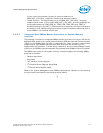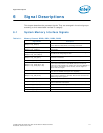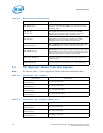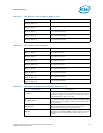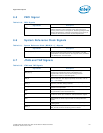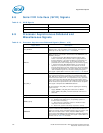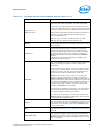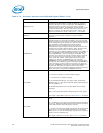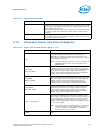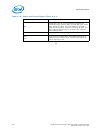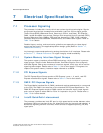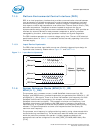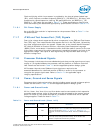
Intel® Xeon® Processor E5-1600 v2/E5-2600 v2 Product Families 123
Datasheet Volume One of Two
Signal Descriptions
MEM_HOT_C01_N
MEM_HOT_C23_N
Memory throttle control. MEM_HOT_C01_N and MEM_HOT_C23_N
signals have two modes of operation – input and output mode.
Input mode is externally asserted and is used to detect external
events such as VR_HOT# from the memory voltage regulator and
causes the processor to throttle the appropriate memory channels.
Output mode is asserted by the processor known as level mode. In
level mode, the output indicates that a particular branch of
memory subsystem is hot.
MEM_HOT_C01_N is used for memory channels 0 & 1 while
MEM_HOT_C23_N is used for memory channels 2 & 3.
PMSYNC
Power Management Sync. A sideband signal to communicate
power management status from the Platform Controller Hub (PCH)
to the processor.
PROCHOT_N
PROCHOT_N will go active when the processor temperature
monitoring sensor detects that the processor has reached its
maximum safe operating temperature. This indicates that the
processor Thermal Control Circuit has been activated, if enabled.
This signal can also be driven to the processor to activate the
Thermal Control Circuit. This signal is sampled after PWRGOOD
assertion.
If PROCHOT_N is asserted at the deassertion of RESET_N, the
processor will tristate its outputs.
PWRGOOD
Power Good is a processor input. The processor requires this signal
to be a clean indication that BCLK, VTTA/VTTD, VSA, VCCPLL, and
VCCD_01 and VCCD_23 supplies are stable and within their
specifications.
“Clean” implies that the signal will remain low (capable of sinking
leakage current), without glitches, from the time that the power
supplies are turned on until they come within specification. The
signal must then transition monotonically to a high state.
PWRGOOD can be driven inactive at any time, but clocks and
power must again be stable before a subsequent rising edge of
PWRGOOD. PWRGOOD transitions from inactive to active when all
supplies except VCC are stable. VCC has a VBOOT of zero volts and
is not included in PWRGOOD indication in this phase. However, for
the active to inactive transition, if any CPU power supply (VCC,
VTTA/VTTD, VSA, VCCD, or VCCPLL) is about to fail or is out of
regulation, the PWRGOOD is to be negated.
The signal must be supplied to the processor; it is used to protect
internal circuits against voltage sequencing issues. It should be
driven high throughout boundary scan operation.
Note: VCC has a Vboot setting of 0.0V and is not included in the
PWRGOOD indication and VSA has a Vboot setting of 0.9V. Refer to
the compatible VR12.0 PWM controller.
RESET_N
Asserting the RESET_N signal resets the processor to a known
state and invalidates its internal caches without writing back any of
their contents. Note some PLL, Intel QuickPath Interconnect and
error states are not effected by reset and only PWRGOOD forces
them to a known state.
RSVD
RESERVED. All signals that are RSVD must be left unconnected on
the board. Refer to Section 7.1.10, “Reserved or Unused Signals”
for details.
SAFE_MODE_BOOT
Safe mode boot Strap. SAFE_MODE_BOOT allows the processor to
wake up safely by disabling all clock gating, this allows BIOS to
load registers or patches if required. This signal is sampled after
PWRGOOD assertion. The signal is pulled down on the die, refer to
Table 7-6 for details.
Table 6-14. Processor Asynchronous Sideband Signals (Sheet 2 of 3)
Signal Name Description



